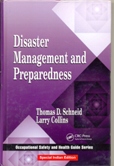
|
DISASTER MANAGEMENT AND PREPAREDESS, INDIAN REPRINT - THOMAS D. SCHNEID (EX) |
Author |
THOMAS D. SCHNEID
LARRY COLLINS
|
|
Cover Price : Rs 2,495.00
|
Imprint : CRC Press
ISBN : 9781566705240
YOP : 2014
|
Binding : Hardbound
Total Pages : 264
CD : No
|
|
From natural disasters to acts of terrorism, you never know when something catastrophic will happen to your organization. But once it does, it is too late to go hunting for a plan of action. Be prepared. Be proactive. Make your disaster management plan before disaster strikes. Disaster Management and Preparedness gives you the how-tos for avoiding the common mistakes which turn natural and man-made catastrophes into economic disasters.
Disaster Management and Preparedness details a new and innovative method for preparing companies and organizations to address the substantial risk of disasters in the workplace. It encompasses not only the tried and true tactics used by safety experts for decades but also focuses on areas often overlooked during the reactive and post disaster phases. Technological progress and terrorist activities has forced safety professionals to rethink their modus operandi for disaster preparedness and expand their proactive measures to safeguard assets on all levels and at all times.
FEATURES
- Addresses special considerations important in planning for disaster
management, from chemical spills, floods, aircraft crashes, and terrorist attacks to catastrophic
events
- Covers all aspects of disaster preparedness from assessing the risk prior
to a disaster to the legal ramifications following a disaster
- Provides the how-tos for dealing with the media and protecting your
organization's assets
- Furnishes OSHA and FEMA regulations, charts, and sample programs
and audits
CONTENTS
Identifying the Risks
Natural Risks
Emerging Risks
Governmental Regulations
Structural Preparedness
Coordinating with Local Assets
Preplanning for a Disaster
Eliminating, Minimizing, and Shifting Risks
Developing an Action Plan
Developing the Written Plan
Effective Communications
Selecting the Right People
Training for Success
Media Control
Shareholder Factor
After A Disaster - Minimizing the Damage
Governmental Reactions
Legal Issues
Disaster Preparedness Assessments
Personal Disasters - Use of Criminal Sanctions
Appendix A - OSHA Inspection Checklist
Appendix B - Employee Workplace Rights
Appendix C - Web Sites for Disaster Preparedness Information and Equipment
Appendix D - Typical Responsibilities
Appendix E - Potential Sources of Disaster Preparedness and Management
Assistance through Local Colleges and Universities
Index
|
|
 |
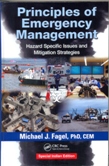
|
Principles of Emergency Management - Michael J.Fagel |
|
|
Cover Price : Rs 3,995.00
|
Imprint : CRC Press
ISBN : 9781439871201
YOP : 2015
|
Binding : Hardbound
Total Pages : 586
CD : No
|
|
Principles of Emergency Management: Hazard Specific Issues and Mitigation offers preparedness and mitigation recommendations for advanced emergency planning. Because disasters are so unpredictable, advance planning is needed to effectively respond to and mitigate against the potential effects of such events.
Whether a disaster is natural or man-made, accidental or deliberate, the best way to protect the public is by implementing an integrated emergency management system incorporating all potential stakeholders through all phases of the event. As such, the book suggests best practices for drills, exercises, and pre-event team building and communication.
More than a dozen contributors offer their professional expertise on a wide variety of topics, including:
-Emergency operations center management
-Continuity planning of vital services in the aftermath of a disaster
-The role of the public health official
-Developing public-private partnerships
-Specific types of disasters, including terrorism, agroterrorism, pandemics, and active shooter incidents
-Mass care, sheltering, and human services
-The special needs of children in disasters
-Traditional and social media and their impact on emergency management
The book is a valuable planning resource for those tasked with managing operations to prepare for, mitigate, and respond to disasters.
Contents
Foreword
Preface
Acknowledgments
Editor
Contributors
1. Introduction: Why Plan for Disasters? M. J. Fagel and S. J. Krill Jr.
2. EOC Management and Operations; L. G. Canton and N. Staikos
3. Continuity of Operations Planning; C. Bowers
4. Strategizing Emergency Management Programs; S. S. Stovall
5. The Hazards among Us; S. S. Stovall
6. The Role of the Public Health Official; M. J. Fagel
7. Developing Public–Private Partnerships in the Twenty-First Century; S. S. Stovall
8. Assessing Vulnerabilities; J. Peerenboom and R. Fisher
9. The Common-Sense Guide for the CEO; M. J. Fagel
10.Planning and Exercise; K. Morgan and M. J. Fagel
11.Planning for Terrorism; M. J. Fagel
12.EOC Center Management during Terrorist Incidents; M. J. Fagel
13.The Active Shooter Incident; R. C. Mathews
14.Terrorist Tradecraft I: The Attack Cycle; R. M. McPartland
15.Terrorist Tradecraft II: Case Studies—Past, Present, and Future; R. M. McPartland
16.Agroterrorism; M. J. Fagel
17.Pandemic Preparedness; D. Himberger
18.Special Events; P. J. Jessee
19.Mass Care, Sheltering, and Human Services; M. Steinle
20.Children and Disasters; M. Steinle
21.Emergency Management and the Media; R. C. Duncan
22.Impact of Social Media on Emergency Management; A. S. Crowe
Afterword
Index
|
|
 |
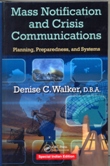
|
Mass Notification and Crisis Communications - Denise C.Walker |
|
|
Cover Price : Rs 3,495.00
|
Imprint : CRC Press
ISBN : 9781439874387
YOP : 2015
|
Binding : Hardbound
Total Pages : 550
CD : No
|
|
Mass communication in the midst of a crisis must be done in a targeted and timely manner to mitigate the impact and ultimately save lives. Based on sound research, real-world case studies, and the author’s own experiences, Mass Notification and Crisis Communications: Planning, Preparedness, and Systems helps emergency planning professionals create a crisis communications plan that works by establishing upfront relationships with responders, enacting protocols, and utilizing technology to effectively message the intended audience.
Providing communication best practices to professionals, the book:
-Reviews the challenges organizations face with communications in the face of various types of disasters
-Helps to outline the target audience of the communiqué
-Describes different communication techniques used throughout history during peace and wartime
-Provides methods for getting the right message across the first time
-Explores how social media can be a powerful tool in message dissemination
-Examines the legal landscape to ensure managers are in compliance with international, federal, state, and local regulatory requirements
Aligned with the U.S. Department of Homeland Security’s National Emergency Communications Plan—as well as the U.S. strategic plan to improve emergency response communications—the book provides recommendations to key decision makers given all considerations that must be weighed and factored in
during a crisis.
Contents
Preface
History of Communications
Disaster Communications—Two-Way Conversations
Dynamics of Communications and Concepts of Operations
Challenges to Effective Communications
Changing Realities in Emergency Communications
Emergency Communications Framework
A Crisis Occurs … Now What?
International, Federal, State, and Local Laws, Regulations, Systems, Plans, and Structures
Ripple Effect of Social Media and Social Networking
Solutions—Some Solutions Are Better than None
Learning Your Systems Requirements
Picking a Solution That Fits
Effective Communication Plans
Getting the Message Right the First Time
Prepare to Prosper
Conclusions
Appendix A: List of Acronyms
Appendix B: Sample Mass Notification System Activation and
Criteria Guidance Sheet
Appendix C: Sample Messages
Appendix D: List of Questions to Ask a Vendor before You Buy
Appendix E: Sample Social Media Strategy
Appendix F: Emergency Call Numbers
Glossary
Additional Resources
Index
|
|
 |
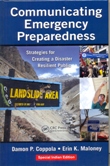
|
Communicating Emergency Preparedness - Damon P.Coppola |
Author |
Damon P. Coppola
Erin K. Maloney
|
|
Cover Price : Rs 2,495.00
|
Imprint : CRC Press
ISBN : 9781420065107
YOP : 2015
|
Binding : Hardbound
Total Pages : 286
CD : No
|
|
Recent events worldwide have made disaster preparedness and disaster communication to the public a crucial concern. September 11th, the Indian Ocean tsunami, Hurricane Katrina, and other mega-disasters have highlighted not only a woeful lack of community awareness of vulnerability but also the absence of a clear protocol for what to do as events unfold. The first book dedicated solely to the topic of pre-disaster communication, Communicating Emergency Preparedness: Strategies for Creating a Disaster Resilient Public presents the best ways to inform communities about disaster risk factors, response plans, and emergency procedures without fomenting panic or paranoia.
With an emphasis on protecting the community by raising public awareness, this volume:
• Contains historical facts and figures about public awareness and preparedness campaigns and their influence on behavior
• Examines and details deficiencies in current disaster preparedness public education efforts and offers real-world solutions
• Provides step-by-step instructions on planning and conducting a public education effort
• Includes a series of case studies which identify various public awareness campaigns that have been successfully conducted in communities
Recognizing that knowledge is the best defense, this practical resource provides public administration officials, emergency managers, evacuation coordinators, and community leaders at the local and national level with the background and tools needed to plan, design, and carry out effective public disaster preparedness campaigns.
Contents
Acknowledgments
Introduction
About the Authors
Public Disaster Preparedness: In Theory and In Practice
Managing Risk, Emergencies, and Disasters
The Campaign — Step 1: Early Planning
Step 2: Develop a Campaign Strategy
Campaign Implementation and Evaluation
Program Support
Emergency Management Public Education Case Studies
Appendix:
Index
|
|
 |
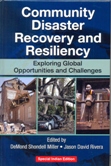
|
Community Disaster Recovery and Resiliency - DeMond Shondell Miller |
Author |
DeMond Shondell Miller
Jason David Rivera
|
|
Cover Price : Rs 3,995.00
|
Imprint : CRC Press
ISBN : 9781420088229
YOP : 2015
|
Binding : Hardbound
Total Pages : 634
CD : No
|
|
In the past, societies would learn from disasters and move the location of their urban development to safer areas, allowing naturally occurring ecosystems to maintain themselves and for societies to exist symbiotically with the environment. These days, however, it seems that society no longer takes cues from the environment but rather relies on technical advancement to attempt to control and overcome the environment, sometimes with wholly unsuccessful and even catastrophic results.
Bringing together leading research from top academics and scholars, Community Disaster Recovery and Resiliency: Exploring Global Opportunities and Challenges Emphasizes non-traditional approaches to disaster recovery and rebuilding communities. It highlights the different ways various societies have experienced disasters, learned from them, and revised their thinking about building community preparedness and resiliency pre- and post-disaster.
• Provides a clear, concise, and up-to-date understanding of best practices for rebuilding community institutions and community development after a disaster
• Focuses on integrated solutions for ecological restoration and community development in disaster recovery planning and implementation
• Compares and contrasts community rebuilding between different nations at different stages of development, economic power, and stability
• Includes case studies that illustrate best practices, integrating the concept of community and community rebuilding for local, national, and international stakeholders
All chapters offer diverse community examples that form a framework for comparing best practices. They focus on integrated solutions for ecological restoration and community development and explain how communities can reduce their vulnerability to disasters and reduce recovery time following a disaster. The book indentifies the opportunities and challenges communities are most likely to face on the road to recovery and supplies the interdisciplinary, social scientific understanding required to effectively address those challenges.
Contents
OPPORTUNITIES AND CHALLENGES FOR BUILDING A COMMUNITY-BASED INSTITUTIONAL INFRASTRUCTURE; DeMond S. Miller
Disaster Preparedness among Community-Based Organizations in the City and County of San Francisco: Serving the Most Vulnerable; Liesel Ritchie, Kathleen Tierney, & Brandi Gilbert
Safe Schools for the Community: A Case and Tool for Disaster-Proof Schools; Sanjaya Bhatia
Opportunities and Challenges of Battered Women’s Shelters in the Aftermath of a Disaster;Bethany L. Brown
OPPORTUNITIES AND CHALLENGES FOR SOCIAL AND CULTURAL REVITALIZATION;DeMond S. Miller
Disaster Resilience: Exploring All Hazards and Cross Cultural Perspectives; Douglas Paton & Li-ju Jang
Community Resilience in New Orleans East: Deploying the Cultural Toolkit within a Vietnamese-American Community; Emily Chamlee-Wright & Virgil Henry Storr
Social Capital after a Disaster: A Case Study of the 2008 Flood in Cedar Rapids, Iowa; Kevin F. Adler
OPPORTUNITIES AND CHALLENGES FOR ECONOMIC RECOVERY; Jason D. Rivera
Natural Disasters, Climate Change, and Recovery: The Sustainability Question in Post-Ivan Grenada; Jonathan Rosenberg
Information Commodification and Social Capital in Local Street Markets; Michèle Companion
Role of Information and Communication Technologies in Disaster Rehabilitation in Agriculture and Ecotourism: Bukit Lawang, Indonesia; Arul Chib, Anisha Baghudana, & Shilvia Kasdani
OPPORTUNITIES AND CHALLENGES FOR PUBLIC HEALTH AND SAFETY; Jason D. Rivera
The Irrawaddy Crisis: Myanmar and Cyclone Nargis—Challenges and Opportunities for Change; Joel C. Yelin, DeMond S. Miller
Challenge of the Worried Well in the Event of a Pandemic or Terrorist Attack; Thom Curtis
Aborigines’ and Migrant Settlers’ Crisis and Reconstruction Efforts in Two Yoruba Communities in Southwestern Nigeria; Adisa Ademola & Agunbiade Ojo Melvin
An Assault on the Community’s Fabric: Tragedy, Challenges, and Opportunities of Social Shootings; Anita Bledsoe–Gardner
OPPORTUNITIES AND CHALLENGES FOR HOUSING AND HOUSING POLICY; Christopher Gonzalez
Housing Reconstruction in Post-Mitch Nicaragua: Two Case Studies from the Communities of San Dionisio and Ocotal; Esther Leemann
Housing Reconstruction in Tamil Nadu: The Disaster after the Tsunami in India; Jennifer Duyne Barenstein
Building Earthquake-Resilient Communities; Alka Dhameja
OPPORTUNITIES AND CHALLENGES FOR PUBLIC –PRIVATE PARTNERSHIPS IN THE TWENTY FIRST CENTURY; DeMond S. Miller
Bridging the Public–Private Partnership in Disaster Management in Bangladesh; Md. Mahfuzar Rahman Chowdhury
Building Disaster-Resilient Communities: The Public–Private Partnership Approach; Uma Medury
Patterns of Public–Private Partnership in Community Reconstruction: The Case of Taiwan after the Chi-Chi Earthquake; Jou-juo Chu
OPPORTUNITIES AND CHALLENGES FOR DISASTER MITIGATION; Jason D. Rivera
How Nations Should Develop Disaster Plans for Mitigation, Preparedness, Response, and Recovery: Lessons Learned from Major International Disasters; Glenn L. Starks
Private Resilience Responses against Collective Recovery Interests: The Case of the Mega-Fires of Ilia, Greece, in August 2007; Kalliopi Sapountzaki & Anna Papachatzi
Preplanning for Recovery; Julia Becker, Wendy Saunders, Lesley Hopkins, Kim Wright, & David Johnston
Preparedness for Emergency: Learning from War-Caused Disaster in Israel; Alex Altshuler, Faisal Azaiza, & Yael Yishai
Conclusion: From Recovery to Resilience: Long-Lasting Social Change and Disaster Mitigation;Jason D. Rivera & DeMond S. Miller
|
|
 |
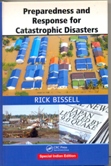
|
Preparedness and Response for Catastrophic Disasters - Rick Bissell |
|
|
Cover Price : Rs 2,995.00
|
Imprint : CRC Press
ISBN : 9781466511897
YOP : 2015
|
Binding : Hardbound
Total Pages : 416
CD : No
|
|
In the Foreword to this book, former FEMA Director James Lee Witt tells us: “The Hard reality is that mega-events, which we now call catastrophes, are too multi-dimensional, too confusing, and have such broad impacts that no single plan, organizational methodology, or agency type can effectively manage the myriad important tasks-nor, perhaps, even consider all that needs to be done-to minimize both immediate and downstream consequences.”
Preparedness and Response for Catastrophic Disasters provides important insight into plans to mitigate and reduce the devastation caused by large-scale catastrophic events.
Written by top disaster scholars and practitioners, this book defines what constitutes a catastrophic event, outlining both the factors that can lead to catastrophes and the unique logistical, planning, and response challenges posed by them. Distinct from general disasters, these events are termed "catastrophic" due to their large footprint, impacts to logistics and infrastructure, the devastating effects on large-scale populations, and the ripple effects on regional and global economies.
Preparedness and Response for Catastrophic Disasters examines why catastrophes must be approached differently. If governments, public administrators, and emergency management professionals are to succeed in protecting our populations, there must be consensus, decisiveness, and leadership in both the coordination and response. In addition, there must be a fundamental recognition that catastrophic events compromise the very infrastructure—public utilities, delivery of goods and service, schools, business functions, and government—that supports communities and upon which modern society is based. As such, the book outlines the ways in which catastrophes can dramatically affect populations and, based on that information, addresses new, innovative, and fundamentally unique strategies we can institute to better prepare populations for catastrophic events and their aftermath.
Contents
Foreword: Why Catastrophes?
Editor
Contributors
Introduction
1. What Is a Catastrophe, and Why Is This Important? Rick Bissell
2. Understanding Catastrophes: A Discussion of Causation, Impacts, Policy Approaches, and Organizational Structures; David A. McEntire
3. Ethics in Catastrophe Readiness and Response; Anna K. Schwab and Timothy Beatley
4. Political and Legal Issues; John C. Pine
5. Economics of Catastrophes and Disasters; Kevin M. Simmons
6. Logistics and the Management of Critical Supplies Following Catastrophes; José Holguín-Veras, Tricia Wachtendorf, Miguel Jaller, and Theresa Jefferson
7. Overview of Critical Infrastructure in Catastrophes; Matthew J. Levy and Rick Bissell
8. Public Health Role in Catastrophes; Rick Bissell and Thomas Kirsch
9. Catastrophes, Mass Displacement, and Population Resettlement; Anthony Oliver-Smith
10.Emergent Organizations and Networks in Catastrophic Environments; Tricia Wachtendorf
11.Methods of Planning and Response Coordination; Jasmin R. Ruback, A. Scott Wells, and Brian J. Maguire
12.Catastrophic Disaster Recovery: An Institutional Network Perspective; Gavin Smith
13.Pandemic Scenario; Rick Bissell and Thomas Kirsch
14.Training and Exercises for Catastrophes; Myra M. Socher
15.Catastrophes in Haiti and Japan; Thomas Kirsch, Nobuaki Kiriu, and Rick Bissell
16.Summary and Call to Action; Rick Bissell and Jasmin R. Ruback
Epilogue
Acronyms and Abbreviations
Index
|
|
 |
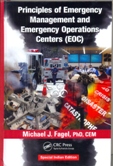
|
Principles of Emergency Management and Emergency Operations Centers (EOC) |
|
|
Cover Price : Rs 2,995.00
|
Imprint : CRC Press
ISBN : 9781439838518
YOP : 2015
|
Binding : Hardbound
Total Pages : 430
CD : No
|
|
Principles of Emergency Management and Emergency Operations Centers (EOC) provides a clear and up-to-date understanding of how an EOC should operate within the guidance of various federal and national programs. The book discusses the processes and systems that must be considered in emergency planning and preparedness efforts.
• Covers the federal guidelines of the National Incident Management System (NIMS) and the standards of the Incident Command System (ICS)
• Presents communication and operational best practices
• Draws on the author’s decades of experience in emergency management, hazmat safety, risk and fire safety planning and preparedness to give insight into the field’s evolution
• Includes helpful checklists and sample documents for improving organizational and interagency operations
The culmination of more than four decades of experience, the text provides time-tested tips for those developing and revising emergency preparedness plans. It details the requirements for appropriate training and planning, both validated by a well-designed exercise program. Stressing the importance of consistency with the various national preparedness initiatives, it covers the latest developments and best practices in the evolving field of emergency management.
Contents
Foreword
Preface
Acknowledgements
Author
Contributors
Reviewers
Introduction; Michael Fagel and Stephen Krill
Assessing Vulnerabilities; James Peerenboom and Ron Fisher
Developing a Planning Team; Michael Fagel
Responder Health and Safety; Michael Steinle
Disaster Preparedness and the Law; Thomas Schneid
Stress Management and Responders; K. R. Juzwin
Developing an Emergency Operations Plan (EOP); Michael Fagel
Developing an Exercise Program; Michael Fagel
Three Types of Exercises; Michael Fagel
EOC Management and Operations ; Lucien Canon and Nicolas staikos
ICS/EOC Interface; Michael Fagel|
Continuity of Operations Planning; Chad Bowers
The Role of Business Continuity Management; Robert Coullahan
Appendices:
Organizing for Homeland Security and Emergency Management; Stephen Krill
Managing Spontaneous Volunteers; Michael Fagel
Emergency Management and the Media; Randall Duncan
Index
|
|
 |
|